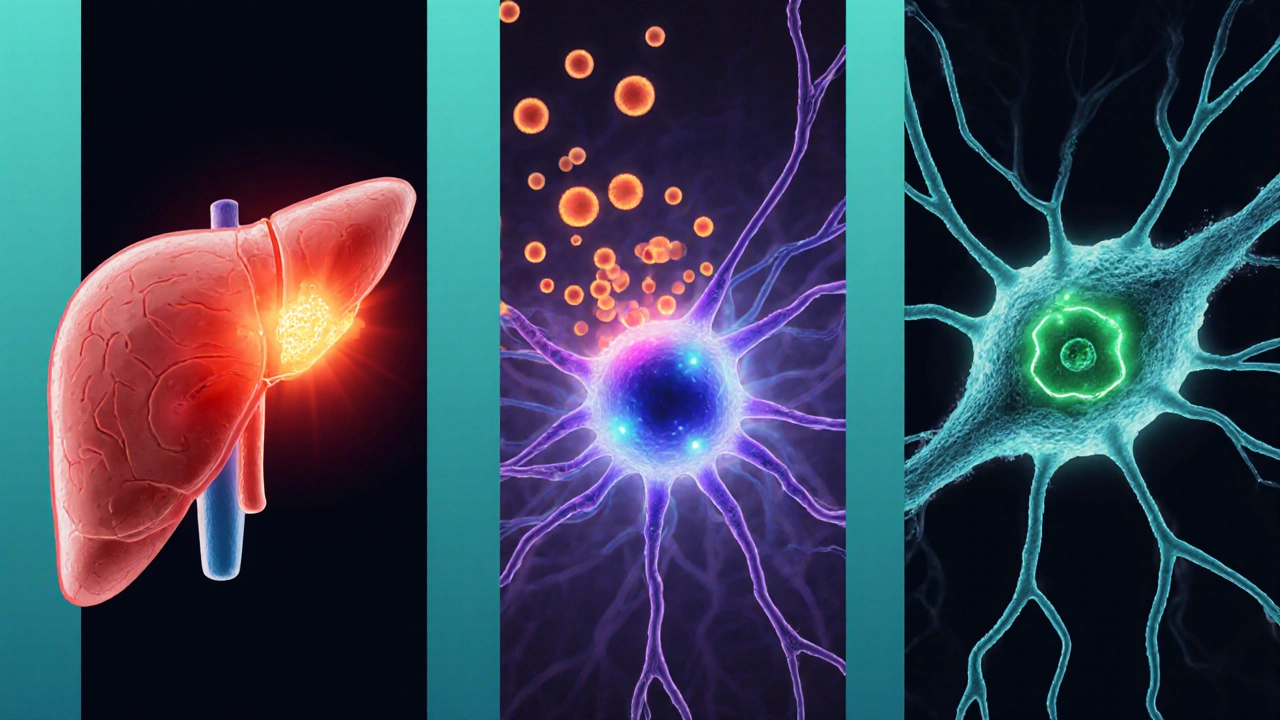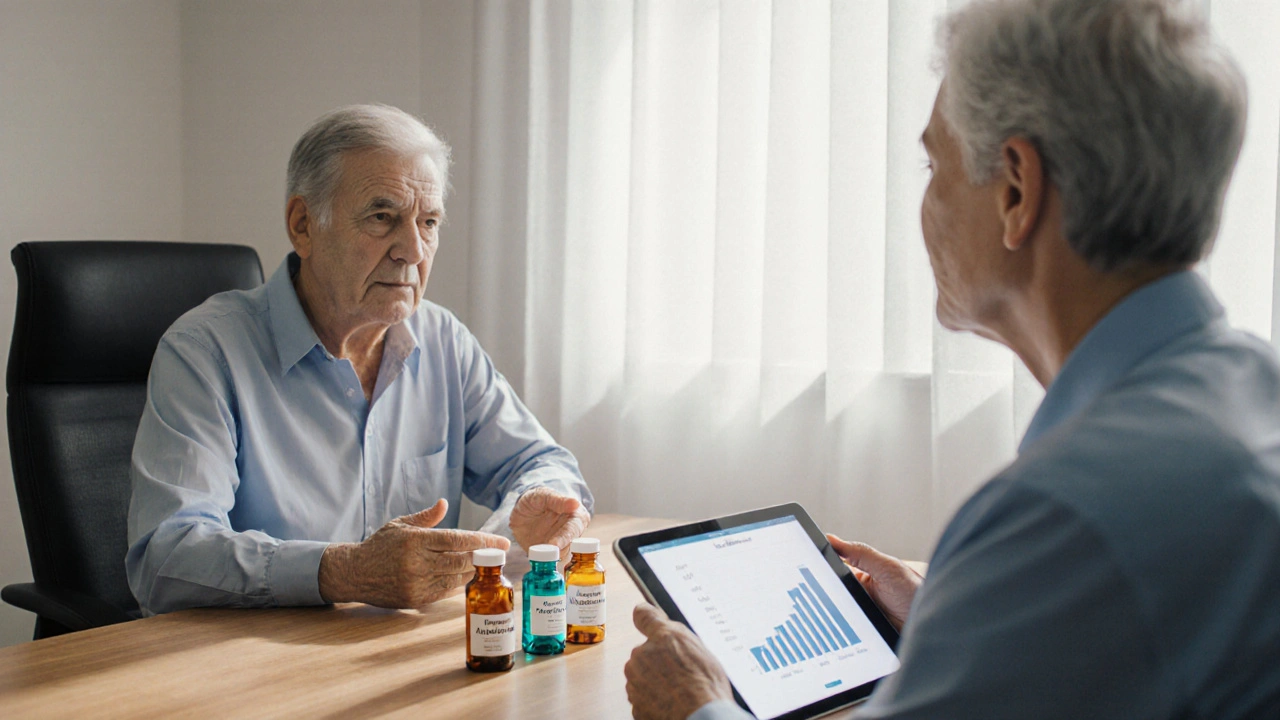Alcohol Dependence Medication Comparison Tool
Mechanism:
Typical Dose:
Common Side Effects:
Major Contraindications:
Effectiveness:
UK Cost:
Important Notes
This tool provides general information about medications used to treat alcohol dependence. Always consult with a healthcare provider before making treatment decisions.
Effectiveness percentages are based on real-world adherence levels and may vary between individuals.
Quick Takeaways
- Disulfiram blocks alcohol metabolism, causing unpleasant reactions if you drink.
- First‑line alternatives - naltrexone and acamprosate - reduce cravings without an aversive reaction.
- Off‑label options like topiramate, gabapentin and baclofen show modest benefits for specific patient groups.
- Effectiveness varies: naltrexone (30‑40% relapse reduction), acamprosate (20‑30%), disulfiram (≈30% when adherence is high).
- Consider liver health, kidney function, and cost before picking a medication.
Disulfiram has been the go‑to drug for "deterrent therapy" since the 1950s, but newer agents address cravings more directly. Below you’ll find a clear rundown of how each option works, who benefits most, and what to watch out for.
How Disulfiram Works
When you consume alcohol, your body first converts it to acetaldehyde, then quickly turns that into acetate. Disulfiram inhibits the enzyme acetaldehyde dehydrogenase, causing acetaldehyde to build up. The buildup triggers flushing, rapid heartbeat, nausea, and headache - a reaction that can last for hours. The idea is simple: you learn to avoid alcohol to dodge the unpleasant symptoms.
Key attributes:
- Typical dose: 250‑500mg once daily.
- Onset of aversive effect: within 15minutes of drinking.
- Requires strict adherence; missed doses remove the protective effect.
- Contraindicated in severe liver disease, cardiac arrhythmias, and pregnancy.
Common Alternatives at a Glance
Three drugs have FDA/EMA approval for Alcohol Use Disorder a chronic condition characterized by uncontrolled drinking and withdrawal symptoms. They target the brain’s reward pathways rather than creating a chemical aversion.
Naltrexone an opioid receptor antagonist that reduces the pleasurable effects of alcohol is taken either as a daily oral tablet (50mg) or a once‑monthly injection (380mg). It works best for people who struggle with cravings.
Acamprosate modulates glutamate activity to stabilize brain chemistry during abstinence is prescribed as 666mg three times a day. It’s most useful for maintaining sobriety after an initial detox.
Off‑label options include:
- Topiramate an anticonvulsant that reduces drinking days by dampening reward signaling - 100‑200mg daily in divided doses.
- Gabapentin originally for seizures, it eases withdrawal anxiety and sleep disruption - 300‑600mg three times daily.
- Baclofen a GABA‑B agonist that may reduce cravings in heavy drinkers - 30‑60mg three times a day.

Head‑to‑Head Comparison
| Medication | Mechanism | Typical Dose | Effectiveness* (relapse reduction) | Common Side Effects | Major Contraindications | UK Cost (approx.) |
|---|---|---|---|---|---|---|
| Disulfiram | Inhibits acetaldehyde dehydrogenase | 250‑500mg daily | ≈30% when adherence ≈80% | Metallic taste, fatigue, rash | Liver disease, cardiac arrhythmia, pregnancy | £30‑£45 per month |
| Naltrexone | Opioid receptor antagonist | 50mg daily or 380mg IM monthly | 30‑40% relapse reduction | Nausea, headache, dizziness | Liver failure (severe), opioid use | £22‑£35 per month (tablet); £130/Injection |
| Acamprosate | Modulates glutamate NMDA receptors | 666mg three times daily | 20‑30% relapse reduction | Diarrhea, abdominal pain, insomnia | Severe renal impairment | £35‑£50 per month |
| Topiramate | Enhances GABA, blocks AMPA/Kainate | 100‑200mg daily | ≈25% reduction (studies vary) | Paresthesia, cognitive slowing, weight loss | Kidney stones, glaucoma | £18‑£30 per month |
| Gabapentin | Calcium channel α2‑δ subunit binding | 300‑600mg TID | ≈15‑20% reduction (adjunct) | Drowsiness, swelling, ataxia | Severe renal failure | £12‑£20 per month |
| Baclofen | GABA‑B receptor agonist | 30‑60mg TID | ≈10‑15% reduction (mixed results) | Muscle weakness, drowsiness | Seizure disorder, severe CNS depression | £10‑£15 per month |
*Effectiveness figures come from meta‑analyses published between 2018‑2023, reflecting real‑world adherence.
Choosing the Right Medication
Think of the decision as matching three pieces: your medical profile, your drinking pattern, and your personal preferences. Here’s a quick decision tree:
- Do you have significant liver disease (AST/ALT >3× ULN) or are you pregnant? Skip Disulfiram and Naltrexone; consider Acamprosate (renal) or off‑label options if kidneys are healthy.
- Is craving the main driver of relapse? Naltrexone or Acamprosate are first‑line; Disulfiram is less helpful because it doesn’t blunt desire.
- Do you prefer a medication that “punishes” drinking? If you’re motivated by an aversive response and can commit to daily dosing, Disulfiram may be suitable.
- Are you on multiple CNS‑active drugs (e.g., antidepressants, benzodiazepines)? Off‑label agents like Topiramate or Gabapentin can interact; review with a pharmacist.
- Cost matters? Generic Naltrexone and Disulfiram are the cheapest; Acamprosate and injectable Naltrexone are pricier.
Regardless of the choice, medication works best when paired with counseling, peer support, or structured programs like AA or SMART Recovery.
Practical Tips & Safety Checklist
- Baseline labs: liver panel, renal function, and pregnancy test (if applicable) before starting.
- Adherence strategy: use a pillbox, set alarms, or involve a family member for daily Disulfiram.
- Alcohol avoidance: remember that even small amounts (e.g., sauce, mouthwash) can trigger a Disulfiram reaction.
- Monitoring: schedule follow‑up at 2 weeks, then monthly for the first 3 months to assess side effects and effectiveness.
- Drug interactions: avoid metronidazole, certain cephalosporins, and CNS depressants when on Disulfiram; check with pharmacist for all options.
Frequently Asked Questions
Can I take Disulfiram and Naltrexone together?
Typically no. Both drugs have liver‑related warnings, and combining them can increase the risk of hepatotoxicity. If cravings are strong, doctors may prefer Naltrexone alone or switch after a washout period.
What happens if I accidentally drink alcohol while on Disulfiram?
You’ll likely experience flushing, rapid heartbeat, nausea, vomiting, and a throbbing headache. The reaction can last 30minutes to a few hours and may be severe enough to require medical attention.
Is Acamprosate safe for people with kidney disease?
Acamprosate is cleared renally, so it’s contraindicated in severe renal impairment (eGFR<30mL/min). Dose adjustments are needed for moderate impairment, and many clinicians avoid it if kidney function is borderline.
How quickly does Naltrexone start working?
Oral Naltrexone begins blocking opioid receptors within 30‑60minutes, but noticeable reduction in cravings usually appears after 1‑2weeks of consistent dosing.
Can off‑label drugs like Topiramate be used without a formal diagnosis?
In the UK, prescribing off‑label is legal but requires documented clinical justification. Physicians typically reserve Topiramate for patients who have not responded to approved meds and can tolerate its cognitive side‑effects.
Choosing the best medication is a personal journey. Use the comparison table, weigh your health status, and talk openly with your prescriber. The right drug, combined with support, can turn the tide on alcohol dependence.


Kelly McDonald
October 4, 2025 AT 14:16Okay but let’s be real - disulfiram is like the ex who shows up at your birthday party with a megaphone screaming ‘YOU SAID YOU’D QUIT!’ It works… if you’re scared enough to care. But what about the people who just want to *feel normal* without getting punished every time they have a glass of wine with dinner? Naltrexone feels like a quiet friend who says, ‘Hey, maybe don’t drink, but I’m not gonna judge you if you do.’ No flushing, no panic, just… less urge. And honestly? That’s way more sustainable.
Joe Gates
October 4, 2025 AT 22:49I’ve been sober for 18 months now and I tried every single one of these - disulfiram made me feel like I was living in a horror movie where every sip of coffee could kill me, acamprosate gave me diarrhea so bad I started carrying a change of pants to work, and naltrexone? That’s the one that actually changed my life. It didn’t make me sick - it just made alcohol feel… boring. Like watching a movie you’ve seen 20 times. The craving didn’t vanish, but it lost its power. And the monthly injection? Best decision I ever made. No daily pills, no guilt, no drama. Just peace. If you’re struggling, don’t give up on meds because one didn’t work - keep experimenting. Your brain deserves a chance to heal without punishment.
harvey karlin
October 6, 2025 AT 17:20Topiramate’s the dark horse here. GABAergic + glutamatergic modulation + AMPA blockade = neurochemical triple threat. Real-world data shows 25% relapse reduction, but the cognitive fog? Brutal. I lost my ability to recall names, forgot where I parked for three days, and started calling my cat ‘the quantum flux capacitor.’ Worth it? Maybe. For high-functioning alcoholics who need to stay sharp at work? Nah. But for someone with binge patterns and zero executive function? Game-changer. Just don’t forget to hydrate or you’ll stone your kidneys.
Anil Bhadshah
October 8, 2025 AT 13:15Just want to add: gabapentin is underrated. I was on it for anxiety after detox and noticed I didn’t crave alcohol anymore. Not because it made me sick - because it fixed my sleep. No sleep = high relapse risk. Gabapentin helped me rest, and rest helped me choose sobriety. Also, it’s dirt cheap. If you’re broke and tired, try this before spending on fancy injections. 🙏
Trupti B
October 9, 2025 AT 05:41Tejas Manohar
October 9, 2025 AT 16:52While the pharmacological profiles presented are scientifically sound, it is imperative to underscore that medication-assisted treatment (MAT) must be integrated within a comprehensive, multidisciplinary care framework. Pharmacological efficacy, regardless of mechanism, is contingent upon adherence, psychosocial support, and patient autonomy. The notion that any single agent can serve as a panacea is both clinically misleading and ethically precarious. Furthermore, cost disparities across therapeutic options must be contextualized within structural healthcare inequities. A patient’s socioeconomic status should not dictate access to optimal care. Therefore, while naltrexone may demonstrate superior efficacy in meta-analyses, its accessibility remains limited for marginalized populations. Policy reform must precede clinical recommendation.
Mohd Haroon
October 9, 2025 AT 21:09There is a deeper truth here, often unspoken: addiction is not a disease of the brain alone - it is a fracture in identity. Disulfiram treats the symptom, naltrexone dulls the signal, but who are you when the craving is gone? The real question isn’t which drug works best - it’s whether you are ready to meet yourself without the crutch of alcohol. Science gives us tools, but healing requires courage. And courage is not found in pill bottles. It is found in silence, in the morning after the storm, when you wake up and choose to live - not just abstain.